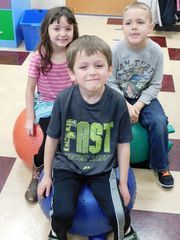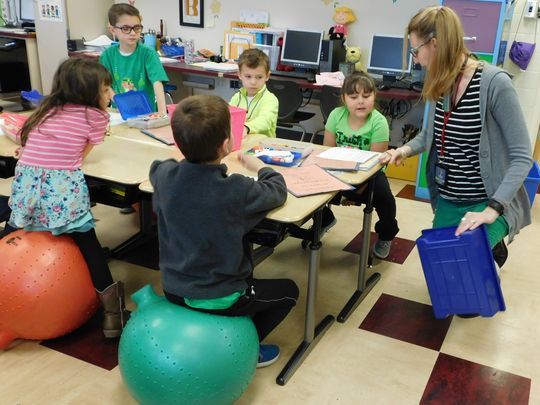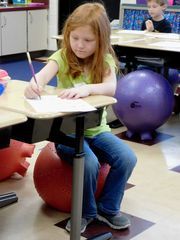THE BOSTON GLOBE, MARCH 20, 2017
WALTHAM — Teachers of another generation may have had little patience for fidgety students. Students were expected to sit with both feet on the floor and hands on top of their desks, while their backs rested often uncomfortably against the wooden backs of their chairs.
But don’t expect second-grade teacher Kelly Fitzpatrick to tell her Northeast Elementary School students to “sit still.” Instead, she is providing an outlet for their energy— replacing many classroom chairs with exercise balls, standing desks, yoga mats, and plastic stools that wobble in all directions.
To Fitzpatrick’s surprise, students seem more attentive in the new seating than in traditional desks and chairs.
Across Massachusetts, teachers are increasingly embracing a lesson learned from the dot-com world: different types of seating can make folks more comfortable, which in turn can boost productivity and creative thinking.
Balancing on an exercise ball or a “wobble” stool can also bring health benefits, from burning more calories to strengthening core muscles, which could yield some critical gains as schools do their part in combating childhood obesity.
Flexible seating is popping up in classrooms in many communities, including Boston, Braintree, Chelmsford, Malden, and Plymouth. The movement has been organic — teachers copying colleagues in their schools or picking up ideas on social media where teachers are chronicling their efforts.
The transition is not always easy, as Fitzpatrick can attest. The sight of her 7- and 8-year-old students bouncing up and down and wobbling around during the day’s lessons took some getting used to, she acknowledged.
“I’m a Type A personality,” she said. “I like rigid routines and I’m very organized.’’
But many teachers are so committed to the change that they are funding the transformations themselves, opening their wallets or crowdfunding. While an exercise ball can cost as little as $10, a wobble stool can go for $70 or more.
In many cases, the rooms are becoming the highlight of a student’s day.
At Nettle Middle School in Haverhill Friday morning, some seventh-graders rocked back and forth on wobble stools as they read a book in an English class. Others sat at traditional desks with attached chairs, but they bounced their feet on a bungee cord their teacher, Diane Gentile, had stretched across the width of the desk legs.
In the back of the room, a half-dozen students sank into disk-shaped cushion chairs, fixtures in many college dormitories, and kicked their feet up on ottomans as they read a book or wrote their part of a fictional story they were circulating.
“We are more chill than being at our desks,” said Maya Lancey, nestled into a disk chair and using a clipboard to write on. “If you are more comfortable, you won’t get up as much to walk around.”
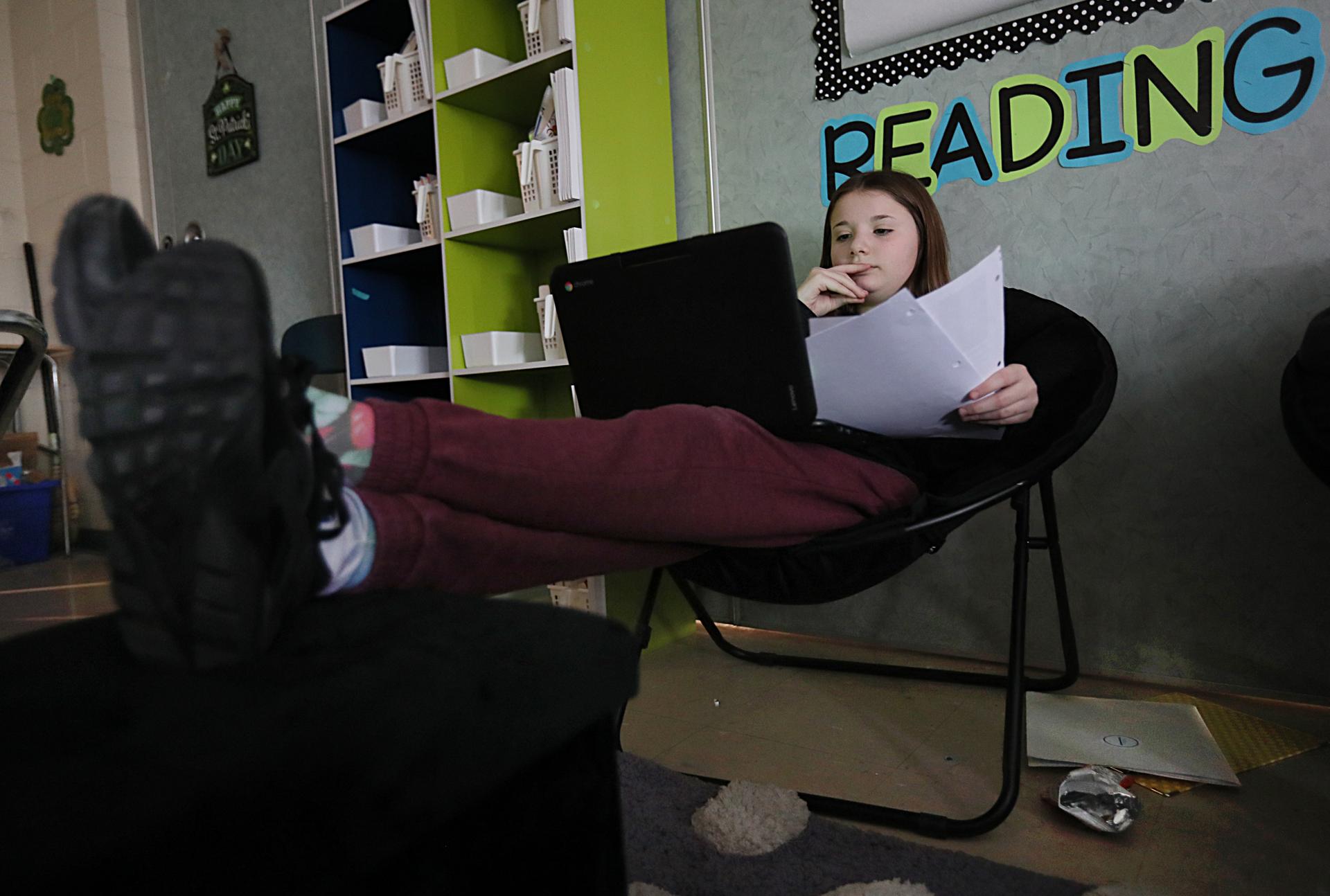
Kallyn Lavalle, 12, studied for a test with her feet up at the Nettle Middle School.
Her classmate Troy Gagne, 12, likes the wobble stools and the bungee bands, saying, “It gives me something to do instead of tapping my feet on the ground and being a distraction to others.”
Gentile, who is in her first year of teaching, initially set up her desks in the fall in rigid rows, but she said, “It felt too much like a classroom my grandparents would have gone to.”
She drew inspiration from a colleague, Jennifer Donais, who has hauled in some unconventional choices into her classroom: a high-top patio set, a blow-up chair, and a futon.
The new wave of furniture is a far cry from the days when schools bolted their desks to the floor and insisted that students sit with both feet on the floor and hands clasped on top of their desks.
Fidgeting during those days was a behavior deemed in need of correcting.
Such rigid order is no longer as necessary in education, said Daniel Wilson, educational chair of Learning Environments for Tomorrow at Harvard University. He said schools have moved away from a model of “transmitting knowledge into the heads of students” to one where students are encouraged to work in groups to solve problems and do hands-on projects or other assignments that foster problem solving, critical thinking, and creativity.
But, he said, schools still need to be methodical about the furnishings they choose.
“Letting students sit on yoga balls might be more comfortable for them, but are they going to learn multiplication tables better or empathy?” he said. “Often decisions about furnishings and space design may feel good or look good, but that’s not enough. It needs to serve some educational purpose. It can’t just be flashy or comfy.”
Little research exists on whether flexible seating boosts student achievement or promotes better behavior. But anecdotal evidence from teachers, students and parents suggests there could be a connection.
Erin Nugent said she noticed a change in her son after his first-grade teacher, Jessica Sabino, adopted flexible seating in January at the Forest Avenue Elementary School in Hudson. He hardly complains anymore that school is too long and he argues less about sitting and doing his homework.
“Whether that’s a maturity thing or the seating I don’t know, but he does talk positively about the seating,” she said.
Teachers acknowledge that flexible seating could backfire if not implemented well.
In Waltham, Fitzpatrick had each of her second-graders sign a contract agreeing to use the seats for their intended purpose, a practice that many teachers have adopted. So, in other words, no kicking the exercise balls around or throwing them in the air.
She also reminds students each day to choose a seat that is best for them and not one that is simply next to their best friend.
Relinquishing control of her seating charts was a gamble, she said, noting that teachers cherish the power to separate chatty buddies and to foster relationships with other students.
“I have a really well-behaved class this year and I trust them,” she said, “but next year you never know what might be coming down the road.”
One of the favorite seating options among her students is a table lowered to 16 inches off the floor and surrounded by yoga mats, making students feel like they are working at a coffee table.
“I like sitting on the floor,” said Maria, 7. “I’m afraid of heights.”
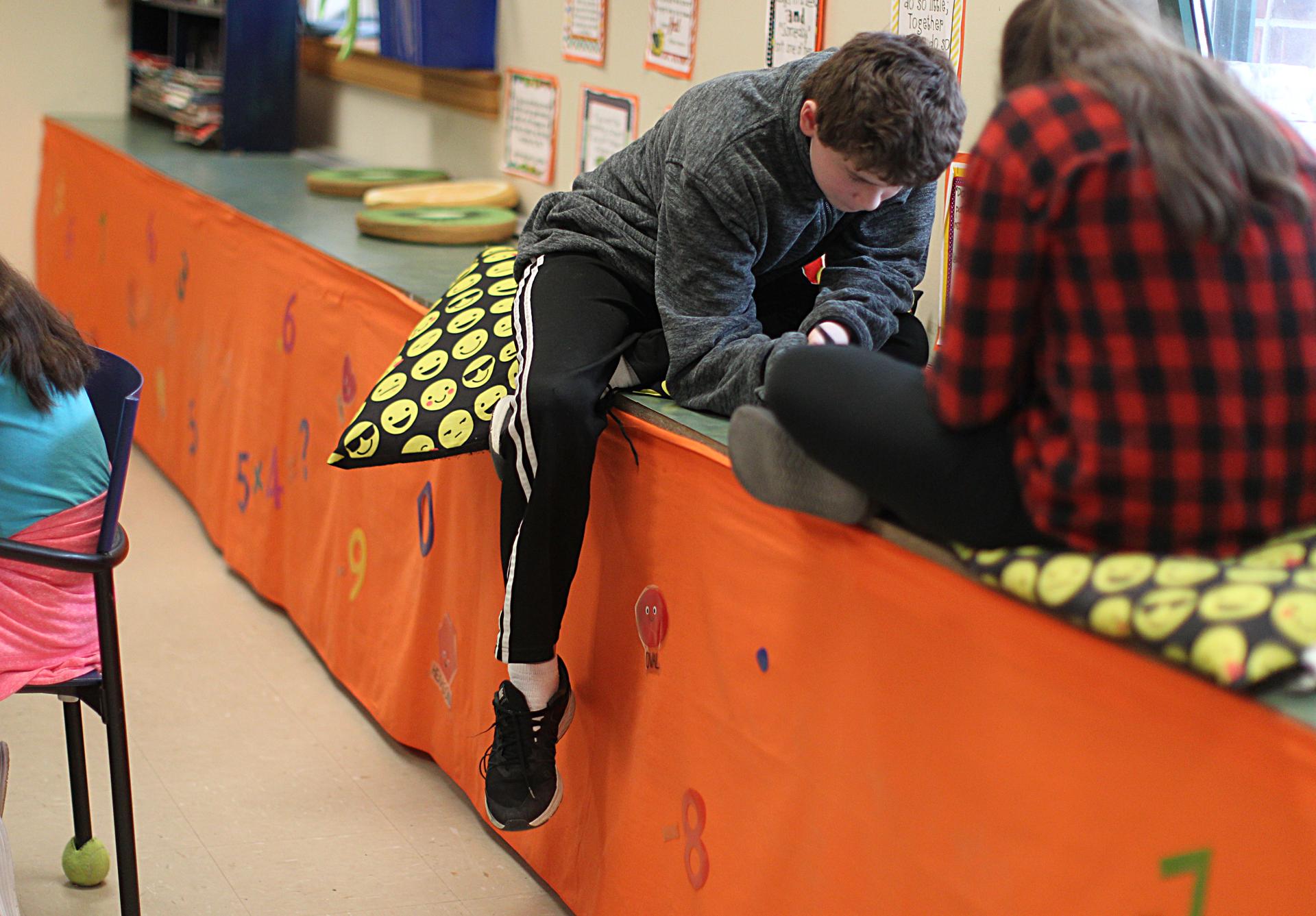
Casey Decoteau, 12, sat on a pillow on a window bench during class at the Nettle Middle School.
~James Vaznis
Wobble Stools | Movement in the Classroom | Stability Balls
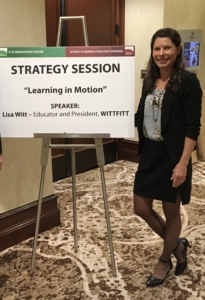
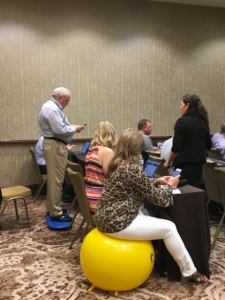
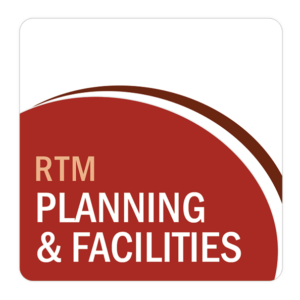
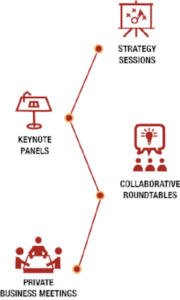
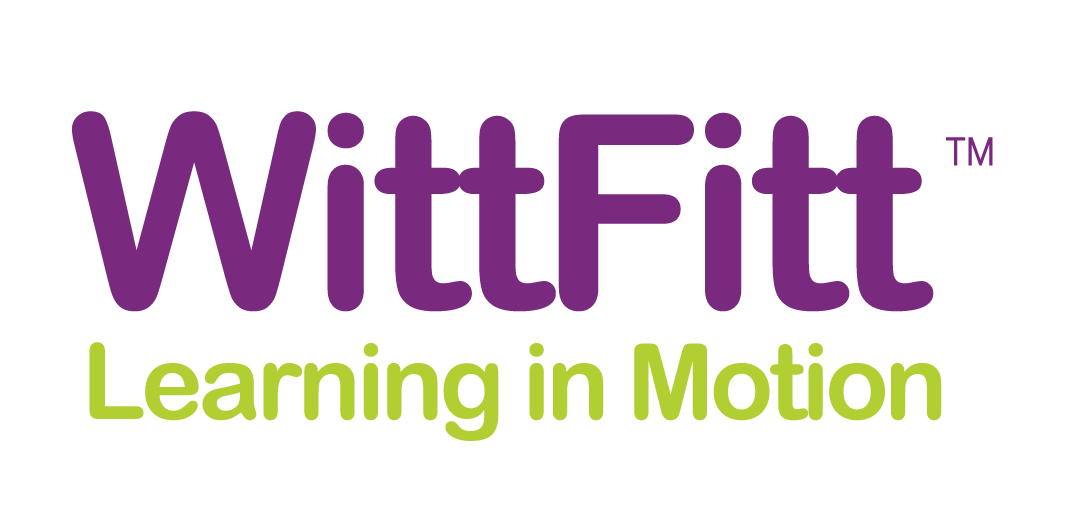

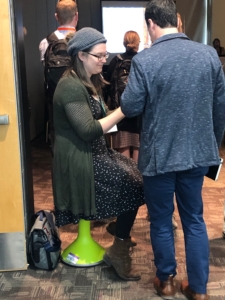
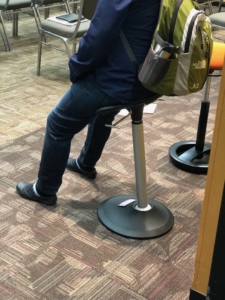
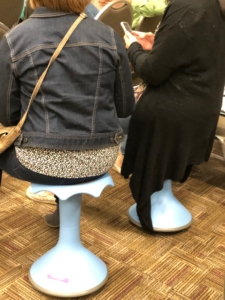
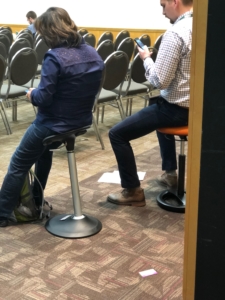




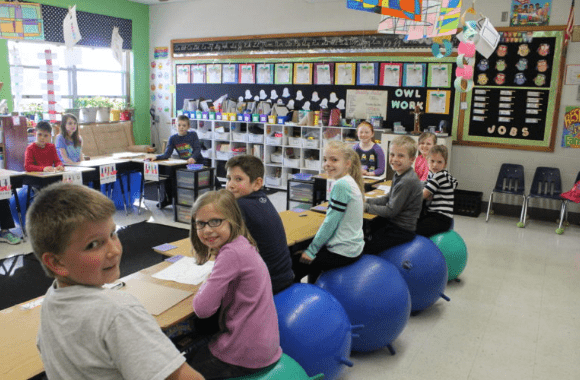
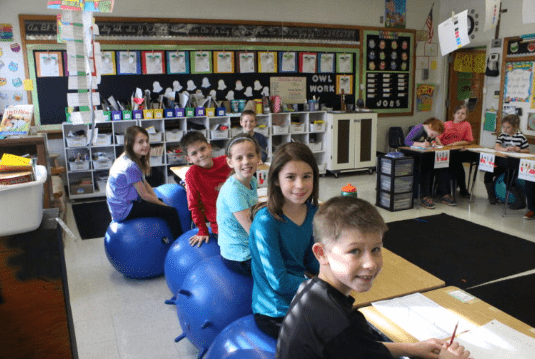
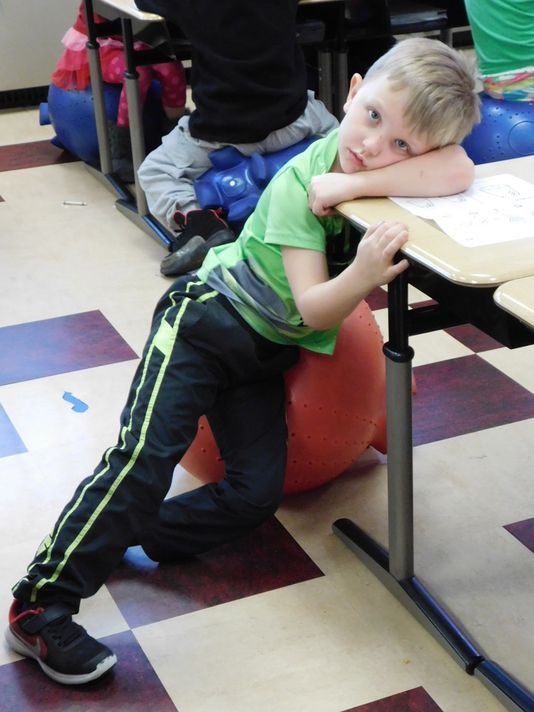 CLYDE – The pupils in kindergarten teacher Aubrey Baur’s class usually have a ball — actually, they sit on ball chairs.
CLYDE – The pupils in kindergarten teacher Aubrey Baur’s class usually have a ball — actually, they sit on ball chairs.